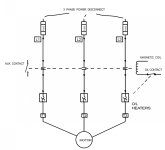What a laugh, as a nearly dead sales rep and sparky, just ask the manufacture which way to wire it, it is pretty basic and you don't need to be an engineer or any duelling (or l could answer correctly). On top of that use common sense which seems to be getting hard to find even in this forum. Or ask Drbits, even with out practical experience he can tell you the correct answer, go DrB.
In all honesty this forum is becoming a laugh. Its an answers for lazy students, or a show off between Drb and Peter which Dr is winning, but Peter of course actually knows what he is talking about, Drb is purely academic but of course very brainy ( how about l acknowledge it, he is easiest the brainiest PLC person here, if not the world, all this is in a very short time, doubley makes us all feel stupid) has nothing better to do apart from show how intelligent he is, which of course he is big time.
I believe has been challenged by his brother the plc expert " and has proven he is within minutes has the handle of PLC's, which of course he has, because he makes everyone here, particularly the long timers ( polite term for the legends) make them look stupid and argumentative and don't even answer here very often and normally to only disagree with Drb.
So Drbit, you have proved your intellect to your brother and if he knows more than you, he must be very proud but he isn't on this site answering school questions, between you and parky all the answer to question for inept too be engineers.
Of course l have to own up to not having your IQ and have learnt it the hard way (but lm not at your level, at least not in the typing) and am not willing to pass it on to someone on the internet.
It saddens me that between you and Parky, you can't even wait for the complete questions before you are giving your complete codes for the F%^^&* wits, you dont even know which PLC's it maybe, so you give different options.
I apologise if l am the only one that thinks this, but look at the posts, you are giving answers with out the OP's putting in any effort.
Stop racing to supply the complete answer and go back to how/why this forum started'
Show your work and then help.
STOP trying to show how smart you are, we all know you are super intelligent, but what you aren't doing is helping the OP's to learn. Between you and Parky, trying to beat each other to the post, let the OP's post something!
Ok l could be totally wrong, l imagine l will find out shortly.
You both have the ery high competences in PLC's, how about letting the Ops have some time between posts to think, think, rethink, write some code then give them some help, not try and beat each other with the answer.
Cheers Kevin







